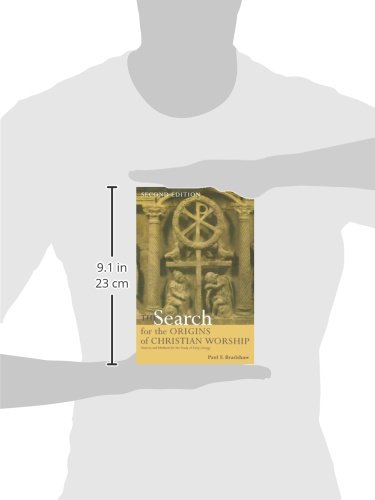Customer Services
Copyright © 2025 Desertcart Holdings Limited
Desert Online General Trading LLC
Dubai, United Arab Emirates



The Search for the Origins of Christian Worship: Sources and Methods for the Study of Early Liturgy
M**S
Liturgical Studies: Bradshaw and Everything Before & After
In his The Early Church: An Annotated Bibliography of Literature in English, Thomas A. Robinson acknowledges the important contribution of this work by Paul Bradshaw. Even Robinson's high praise of the work's significance seems understated in light of its subsequent reception, however.Originally published in 1992, the second edition has been thoroughly expanded and updated and is now widely recognized as heralding a new age in the study of early Christian liturgy (Be sure to buy the current edition if you by used).In the preface, Bradshaw borrows the nomenclature of comparative linguistics which distinguishes between "lumpers" (those who group diverse languages into a few familes) and "splitters" (those who inspect the resulting lumps and find fault lines). This work represents something like the latter approach as applied to the history of primitive Christian worship. Bradshaw summarizes this perspective in four guiding assumptions: 1) We know far less about the first three centuries of Christian liturgical practice than has been previously thought. 2) What we do know points to considerable diversity rather than a previously assumed uniformity. 3) The "classical shape of the liturgy " is more the result of the fourth century assimilation of different traditions than the perseverance of an original apostolic pattern. 4) The post-Nicene era reflects frequent liturgical compromise and mutation rather than the triumph of one way of doing things (though discrete examples of this are not unknown).To cite one example, in his chapter, "Christian Initiation: A Study in Diversity," Bradshaw brings this methodology to bear on the catechumenate itself. After surveying the evidences from Syria, North Africa, Rome, Gaul and Spain, and Egypt, he concludes that one cannot legitimately speak of a standard or normative pattern of early initiation practice in ante-Nicene Christianity. He also concludes that the traditional distinctions between "Eastern" and "Western" practices is likewise illegitimate. While Bradshaw does admit of evidence for some common features that transcend the diversity of local practice (preparatory prebaptismal instruction, a formal act of renunciation and faith, anointing, immersion, and the imposition of hands), he also argues that these features do not always share a common form or meaning. His conclusion is that "there are just too many variations in structure and theology to allow us to construct a single picture in anything but the very broadest terms" (170).Bradshaw readily acknowledges his debt to the prior work of Georg Kretchmar's "Beiträge zur Geschichte der Liturgie, inbesondere der Taufliturgie, in Ägypten" (really the first work to point out the irreducible diversity in the early Christian catechumenate). But Kretchmar's essay suffered for its inability to reach a wide audience. Search for the Origins of Christian Worship, on the other hand, has been widely read and cited as defining a new orthodoxy in the field. Prior work on the early Christian liturgy, however important in particular details, is really subject to revision according to the consensus that has gathered in this volume's wake and subsequent work must account for its concerns.
P**X
Origins of Christian worship
I have found this book very useful in putting into perspective a number of liturgical practices and issues. I can commend this to anyone with an interest in the patterns of liturgical worship.
M**R
good book perhaps could be better
An academic book I bought for a class I was taking . . . insightful, not too lengthy, not overly boring . . . I kept it.
T**I
This book gives a lot of useful information about the liturgical practices of Early Churches
This book gives a lot of useful information about the liturgical practices of Early Churches. One gets a feeling that the author is more inclined to side with the Western theology, at times, to the exclusion of Oriental approach towards this subject. Though the author's mind is western oriented, his pen, definitely, is slanted towards the East. He tries to instill doubts and assumptions, without supporting reasons, to offer alternate explanations for various liturgical and sacramental regimes. Still, quite a useful book.
A**R
A very biased book
The author is looking at history from a very preconceived pointy of view and ignores very much evidence, both internal and external to the scriptures.
A**R
Must read. Timeless classic.
Must read. Timeless classic.
Trustpilot
1 week ago
1 day ago